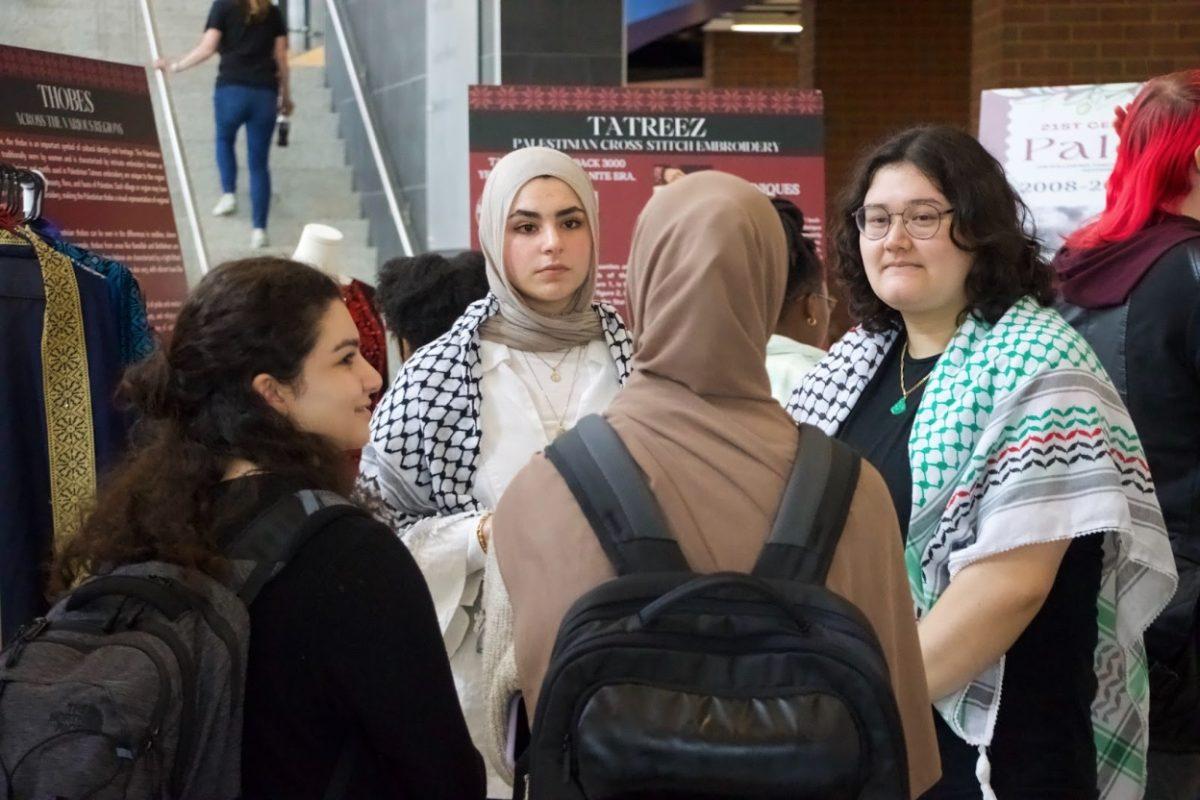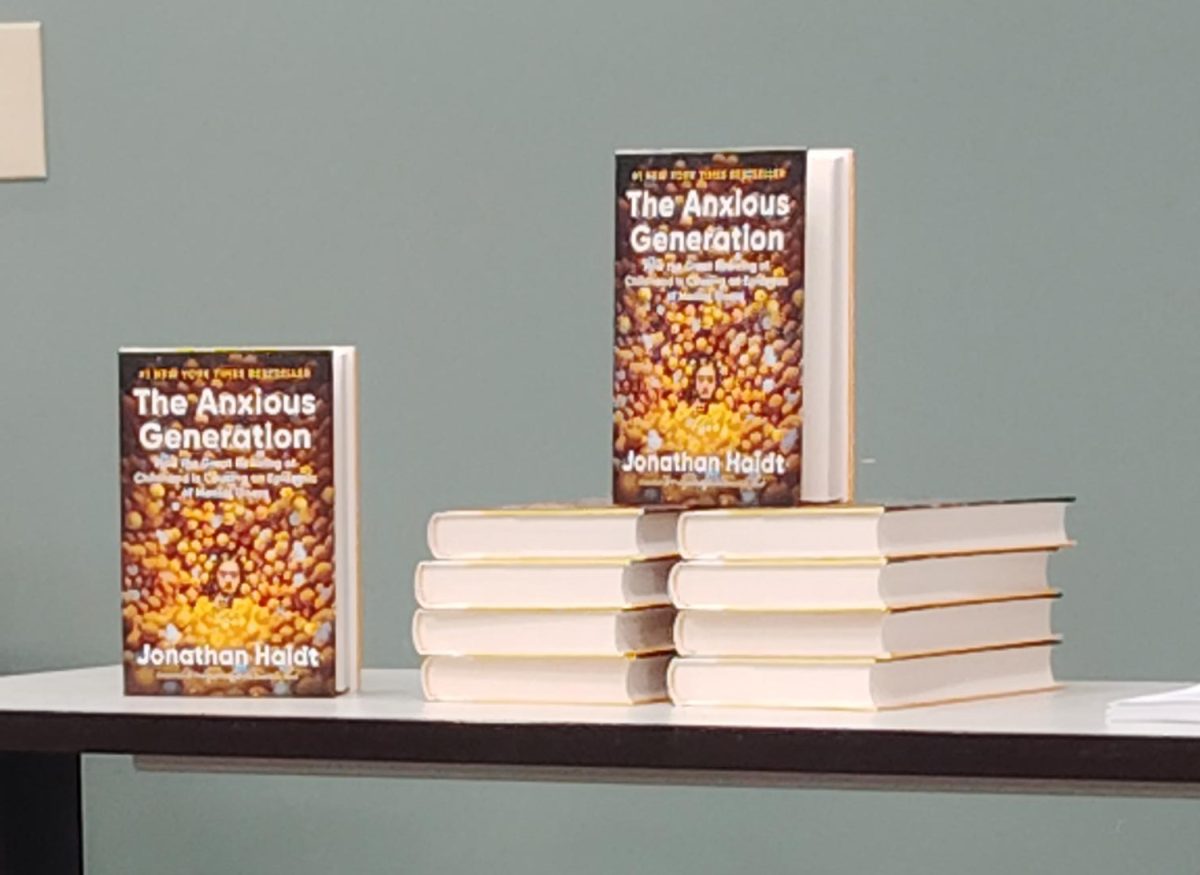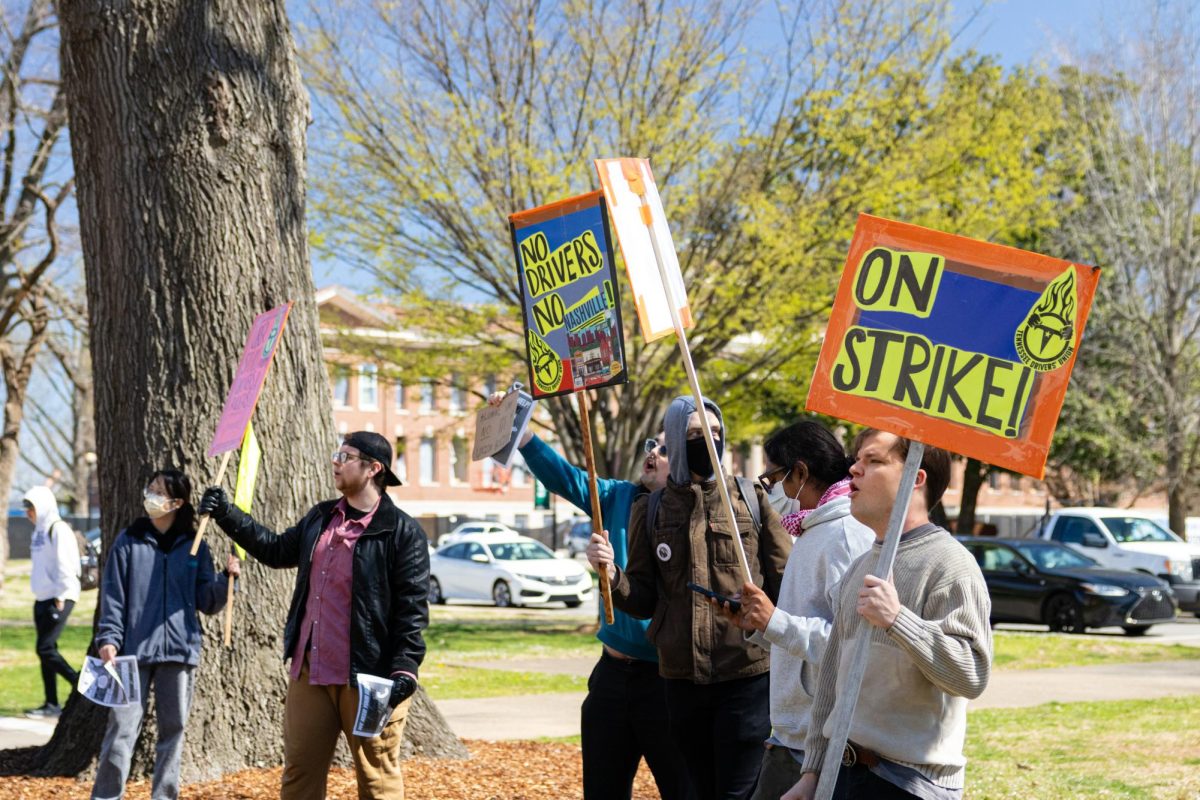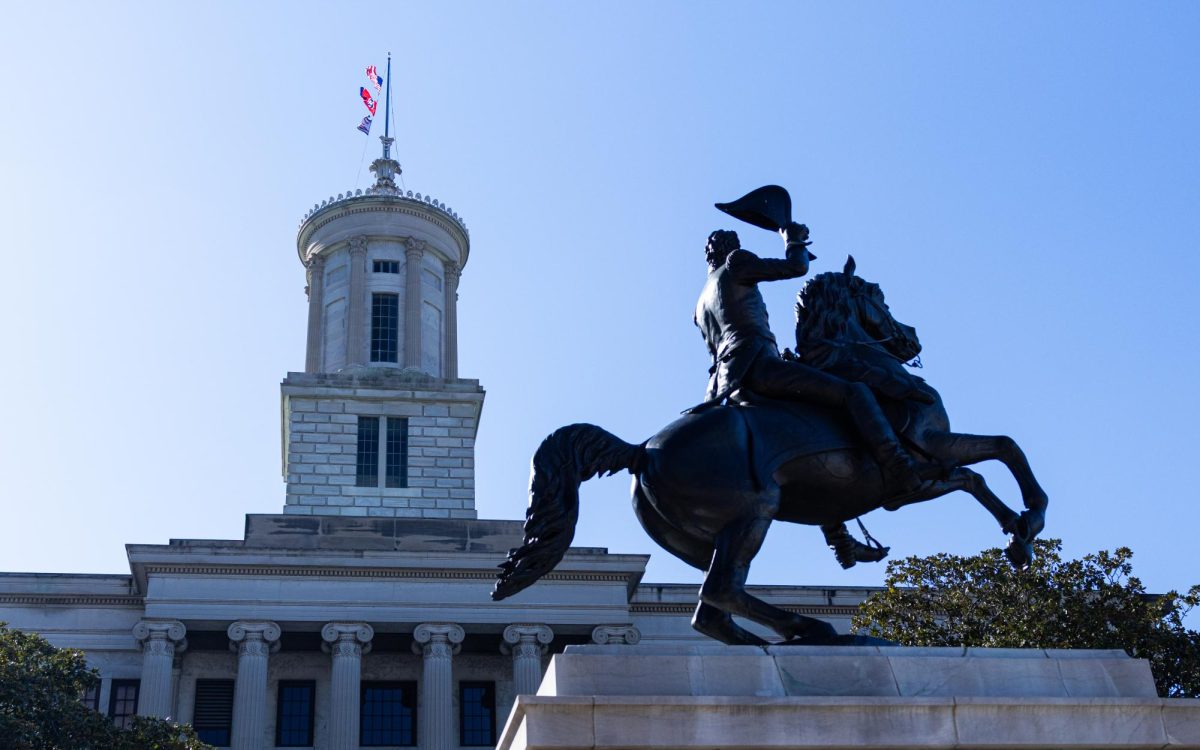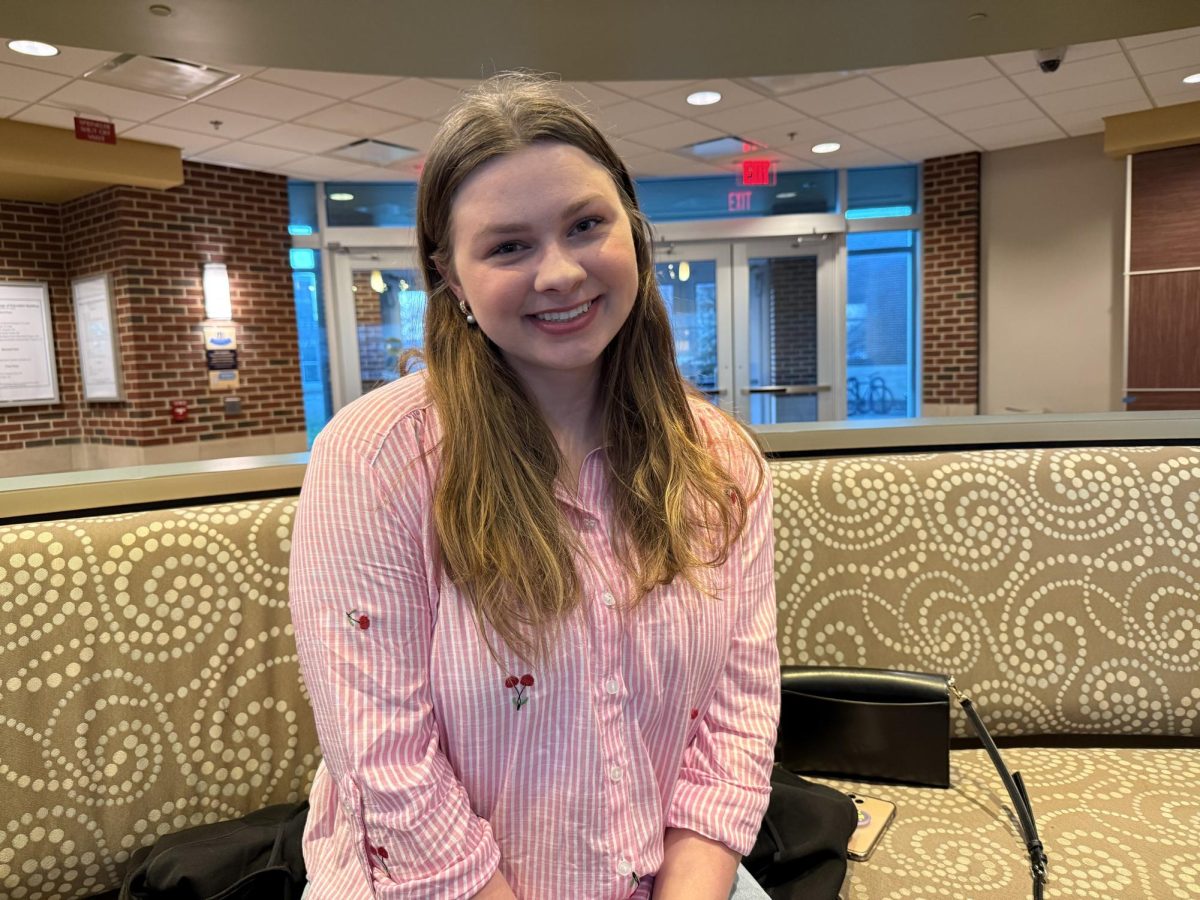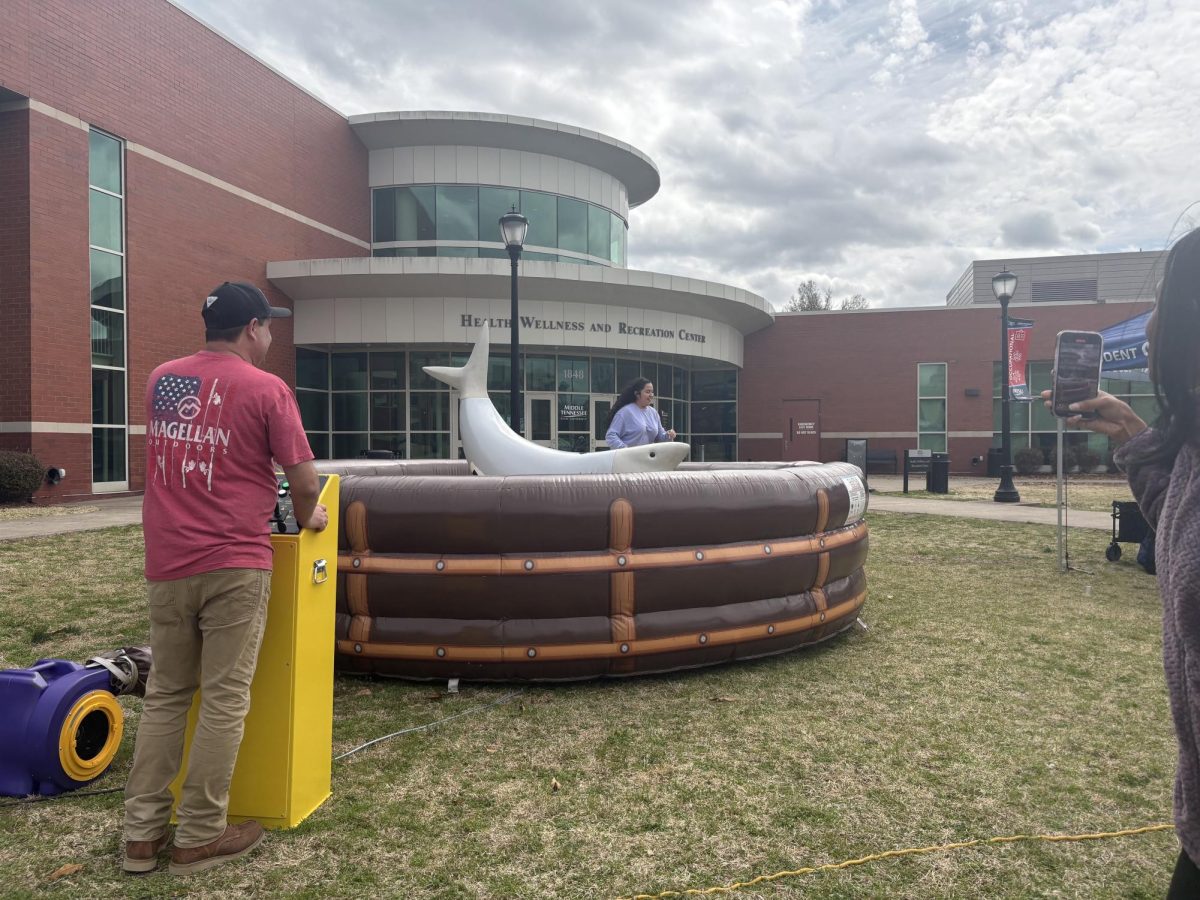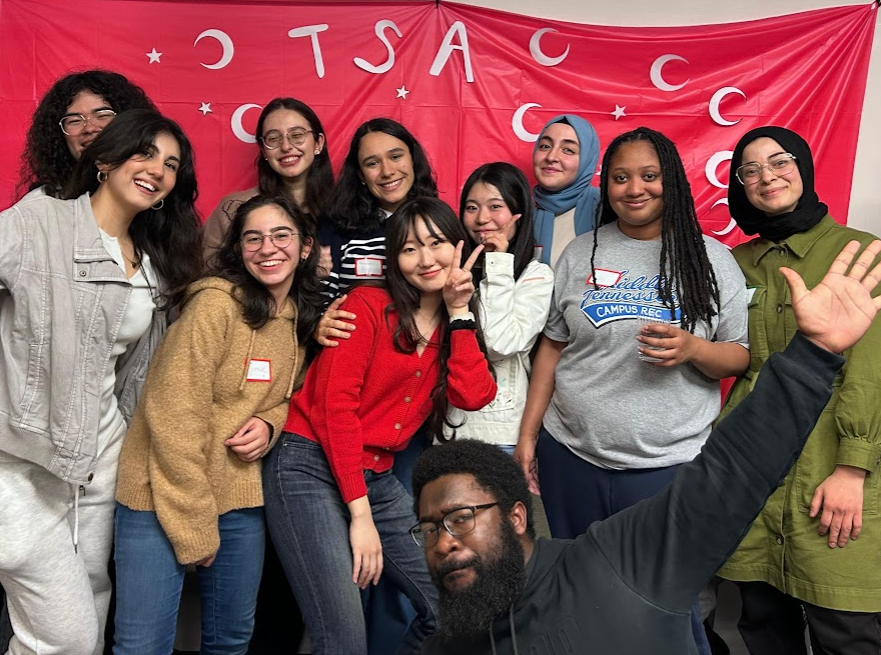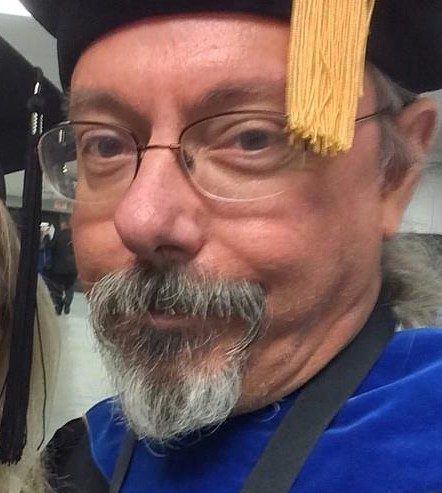Story by Andrew Wigdor, Editor-in-Chief
Updated at 8:45 a.m. on May 3, 2019, for correction: The article originally stated that WMOT switched to Americana in December 2016. The switch was made in September 2016.
With 100,000 watts of pure signal power and carrying the deep and expansive soul of Americana, WMOT Roots Radio, MTSU’s flagship public radio station, has been providing programming to the Middle Tennessee area for 50 years, with its inception in 1969.
The station, 89.5 FM, is celebrating its half-a-century birthday this year, looking back on its impact on the airwaves for listeners and professionals. WMOT hosted an on-campus celebration on April 9, in honor of the same date 50 years ago when the station first came on the air, and the station will be hosting the inaugural 895 Fest, a two-day celebration on May 31 and June 1 that will also celebrate the anniversary. The festival will feature live artists, such as Rodney Crowell and Delbert McClinton, and will be held at the Hop Springs Beer Park in Murfreesboro.
With the advent of its 50th anniversary, take a look below at some of the WMOT workers of the past and present that kept and keep the largest music signal in Middle Tennessee alive and well.
Past WMOT
While it is now an NPR member station powerhouse, WMOT was spawned from humble beginnings. The station only had around 1,000 watts of signal power, which mainly limited WMOT’s reach to MTSU’s campus. It was born after a year of study from an AD HOC committee, and the mission back then was simple – to reflect MTSU in its programming and to create a training ground for students interested in radio and broadcast careers. WMOT was branded as an “educational” radio station and was thrust onto the air, with pop and rock music “interspersed with poignant, lively educational segments and five minutes of campus and national news every hour,” according to a March 1969 Collage article.

“50 years! That’s a half a century. That’s a long time,” laughed Don Coleman, 69, a former MTSU student who worked as the station’s interim news director during its first year of existence in 1969.
Coleman worked at WMOT, which was then housed in the Boutwell Dramatic Arts Building, from the time it went on the air on April 6 to the end of that semester when he left the university. In the age of analog radio and reels of magnetic tape for sound recording, the station was almost entirely student-run, as opposed to the professional leadership in charge today. According to a December 1971 Sidelines article, around 40 students worked at the station in April 1969.
“The station had a very modest beginning, but there was a lot of thought behind it and a lot of dreams and goals,” Coleman said. “From what I’ve seen and heard, it looks like the station has met those goals and surpassed them and is still striving toward the future.”
Due to WMOT’s smaller range of coverage and focus on student involvement during its first few years, the news that Coleman helped produce for the station was very campus-centric. Now, WMOT focuses outward in its news and listener involvement.
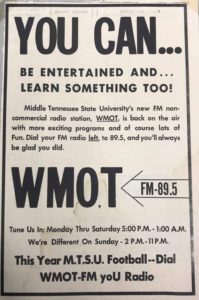
“It was mainly news from and involving the campus and the school,” Coleman said. “(Now), WMOT is not inward looking. Back then, when it was first going on the air, there was no reason to look past inward because we weren’t getting out there. The power of the station when it launched would have been just enough to cover the campus and little else.”
While Coleman didn’t end up graduating from MTSU, he attributes this partially to his commitment and excitement for the station.
“It was an exciting time … I enjoyed it too much, because I flunked out,” Coleman said. “I was spending so much time at the radio station.”
Coleman isn’t the only veteran of the decades-spanning station. Greg Hunt, the current program director for WMOT, has been working behind the scenes and on the air for 40 years. Hunt began working at the station as a student in 1979 and was employed full-time in 1989.
“I’ve always done something here,” Hunt said.
As a first-generation college student majoring in English, Hunt was trying to find where he fit in. Some of his friends noticed that he had a “good voice for radio” and suggested he join the station.
Hunt walked into the station, which was then housed in the Ned McWherter Learning Resource Center on MTSU’s campus, hungry to learn more. He was placed on an afternoon jazz shift, with the station recently being switched to a jazz and news format. Hunt quickly made himself indispensable by taking the late-night shifts others avoided. He said he knew nothing about jazz before taking the position but learned to love the genre as time went on.
“I fell in love with the music, and that’s what kept me there,” Hunt said.
Hunt continued to serve the station in the late-night shifts, garnering special permission from the university president to stay on after graduation. Eventually, a program director position opened at WMOT, and Hunt secured the gig.
When asked about an experience that has stuck out to him over the years, Hunt reminisced about a show he helped produce for WMOT in the ‘90s, titled Improvised Thoughts. It was hosted by Nashville jazz pianist Beegie Adair and consisted of interviews with prominent and internationally-known jazz musicians and producers. The impressive list of interviewees included the likes of Tony Bennett and Diana Krall.
“I never thought I’d get to do that and meet these folks,” Hunt said. “(That program) was one of the high points of my career and, frankly, of the radio station over the decades.”
The interview from Improvised Thoughts that Hunt is possibly most proud of is that of Joel Dorn, a producer for Atlantic Records in the ‘60s.
“He had pretty much carte blanche to sign whoever he wanted to,” Hunt said. “Some of the legendary artists in all of Atlantic Records was discovered by Joel Dorn. To hear some of these stories he had about all of these artists … Joel Dorn was a fascinating individual.”

Hunt said that the largest change in the decades while he’s been at the station is technology. In the past, one of the challenges for WMOT was getting enough student involvement to man all of the on-air shifts. Now, many students can record these shifts from home.
“You can do so much more, and you can do it at your convenience,” Hunt said. “You can do it for four years, your entire college career, and never hear a bit of music that is played during your shifts … That’s one of those things you may miss today in our voice-track world.”
Hunt says that his time at WMOT has not only put his two daughters through college at MTSU, but also provided him with strong relationships. The station has had several different format changes during his tenure – including shifts to classical, rock and blends of several genres and topics – but Hunt hasn’t felt lost due to the support of his coworkers.
“Having been here 40 years, you see a lot of changes,” Hunt said. “The one thing that doesn’t change is your fondness and your friendship with the people who you work with … The people are the things that never change and that you look forward to.”
Present WMOT
While WMOT has undergone many transformations, it has found its home in Americana music. The station made the switch to the genre in September 2016 and hasn’t looked back since.
“When I first came to MTSU and WMOT, we really didn’t have a lot of listeners,” said Val Hoeppner, the executive director of WMOT. “There wasn’t a lot of synergy on campus and in the community. When we changed to Americana, it immediately changed with people coming out of the woodwork to support us, to tell us they’re listening. Our phones didn’t used to ring, and now they ring everyday.”
Directly before the change, WMOT was a news-talk-classical-jazz station with a mix of MTSU athletics. Hoeppner said that one of the issues with the format was in how unpredictable it was for listeners.
“Radio is a habit,” Hoeppner said. “Radio is routine, and it feels like part of your family.”
With its 100,000 watt signal, WMOT now reaches north of Bowling Green, Kentucky, all the way south to the Alabama border. This gives the station, which is now housed in the John Bragg Building’s Center for Innovation in Media, the opportunity to reach 1.7 million people every day.
Hoeppner noted that their reach has, in fact, greatly improved with the Americana format.
“We did not have a good streaming audience back in the day,” Hoeppner said. “Now, we have members that live in the UK and Australia and Prague and Ireland and Scotland. It’s crazy.”
With the genre’s deep roots in the Nashville area, Hoeppner and the WMOT crew work to give listeners the modern Americana experience and to help them look back at the foundation of the genre.
“Americana music, the majority of it, is made right here … ,” Hoeppner said. “I hate the word ‘preserve’ because this music is alive, and when we play it, it lives on. It is our mission to educate people on where the sounds that you’re hearing now came from.”
Hoeppner says that, due to the way that WMOT is programmed, listeners often get to hear an up-and-coming Americana musician, followed by music that informed and influenced those new musicians
Along with the genre switch, the student involvement has grown as well. WMOT began in 1969 as a training ground for students, and Hoeppner has attempted to reinvigorate this goal. When she started as executive director in 2015, the station only had one student worker. There are now over 20 students on the station’s payroll.
“We needed to be training more students,” Hoeppner said. “… Not only do they get to listen to the music and come to our events, but students power this radio station through paid jobs in promotions, in public relations, in news, in audio production and video production.”
One such student is MTSU senior Olivia Anchondo. Anchondo first became involved with WMOT three years ago when Hopenner offered her a position.
“I had no interest in radio before,” Anchondo said. “In fact, I never listened to the radio … It’s just one of those freak things that turned into something incredible.”
Anchodo handles public relations and social media management for WMOT, but has also been involved in production, running cameras for the station’s live shows, graphics and more.
“They call me the swiss army knife,” laughed Anchondo.
Of Anchondo’s many experiences with WMOT, one that sticks out is when she was able to work for the station at this year’s South by Southwest Conference and Festivals in Austin, Texas.
“That was incredible,” she said.” It was something that I did not expect at all.”
WMOT had their own South by Southwest day-stage at a restaurant this year. The station booked 30 artists in five days and streamed their performances, which acted as a fundraiser for WMOT. Anchondo was in charge of aspects such as getting video releases signed, speaking with artists’ agents and overseeing the stream.
She said that the relationships she’s built at the station will last a lifetime, and she’s been able to build a professional network for her time after graduation.
“Being the person in promotions, I do a lot of artist management and working with the artists when we have shows,” she said. “I’m meeting these people, and my bosses are telling them, ‘Hey, you want to hire her after she graduates.’”
Anchondo said that, after graduation on Saturday, she’s not worried about landing her first job due to the foundation she’s built at WMOT. Anchodo hopes to continue to combine music business and public relations.
Anchondo said that, as a newer addition to the WMOT team, she hasn’t seen as much of the changes and journeys that the station has been on, but she still appreciates the legacy that 50 years leaves behind.
“Since day one, the station has always provided music that is worth more than just plays or streams or money,” she said. “It’s an experience.”
To contact News Editor Angele Latham, email newseditor@mtsusidelines.com.
For more news, visit www.mtsusidelines.com, or follow us on Facebook at MTSU Sidelines or on Twitter at @Sidelines_News



